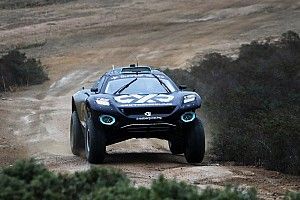De Villiers forced to settle for fifth in stage 11 flood conditions
Rain stops play for South African Toyota team on stage 11. De Villiers and Von Zitzewitz consolidate second place overall with three days to go.

Photo by: Red Bull Content Pool
It was a case of rain stopped play on day 12 of the Dakar Rally on Wednesday. Rivers swollen by heavy rain came down in flash flood and prevented competitors from completing the day’s special stage 11 between La Rioja and Fiambala in Argentina. The organisers were forced to halt the already shortened 190-kilometre special stage with Giniel de Villiers and Dirk von Zitzewitz leading at the 110 kilometre mark in their South African-built Imperial Toyota Hilux #301.
But there was disappointment for the 2009 Dakar winners and their Toyota Imperial South Africa Team. The race officials declared the stage result as per the positions at the earlier CP1 (control point one) at the 67 kilometre mark, giving the win to the Americans Robbie Gordon and Kellon Walch in a Hummer ahead of Ronan Chabot and Gilles Pillot of France in an SMG Buggy and Argentinian duo Lucio Alvarez and Roland Graue in a South African-built customer Toyota Hilux.
De Villiers and German co-driver Von Zitzewitz had to settle for a disappointing fifth place ahead of race leaders Stephane Peterhansel and Jean Paul Cottret of France in a Mini. The 40-year-old from Stellenbosch was in attack mode and took the lead ahead of Gordon and Peterhansel soon after CP1. It was clearly his intention touse the notorious Fiambala stage, a thorn in the side of many drivers in the past, to close the gap to Peterhansel and increase his 16-minute advantage over the third-placed Russians, Leonid Novitskiy and Konstantin Zhiltsov, in a Mini. He was well on his way to achieving these goals when the flood waters intervened.
“Giniel started slowly to protect the tyres in the rocks but once in the big dunes Dirk gave perfect direction and Giniel kept an accurate heading,” reported Toyota Imperial South Africa team manager Glyn Hall.“When the race was stopped he had reached waypoint 11, 110 km into the special, 10 minutes ahead of the field and 16 minutes faster than Peterhansel.”
“It’s a pity what happened today, because we were first on the road,” said De Villiers. “We’d passed Robbie and Stephane. It was not a lucky break for us.”
It was a lucky break, however, for the Russians. They had encountered problems and lost a lot of time up to the point the rally was stopped and dropped further behind De Villiers and Von Zitzewitz, but were awarded the same time as the slowest finisher on the interrupted stage at the neutralisation point.This put them over 18 minutes behind De Villiers and Von Zitzewitz on the stage and they are now more than 34 minutes in arrears in the overall classification.
So the top three positions in the general classification with three days remaining of the 8 500-kilometre marathon rally between Lima in Peru and Santiago in Chile are: 1 Peterhansel/Cottret (Mini) 29 hr 7 min 25 sec, 2 De Villiers/Von Zitzewitz (Toyota Hilux) +51.59 sec, 3 Novitskiy/Zhiltsov (Mini) +1 hr 26 min 40 sec.
The other four South African-built customer Toyota Hilux 4x4s are all still in the top 20, with Australian Geoffrey Olholm and Briton Jonathan Aston 11th overall, Adam Malysz and Rafal Martin of Poland are 14th, Argentinians Lucio Alvarez and Roland Graue 15th and Nunzio Coffaro and Daniel Meneses of Venezuela 17th.
Thursday’s stage from Fiambala in Argentina to Copiapo sees the surviving car competitors (only 96 out of an original 153 started Wednesday’s stage) cross the Andes Mountains from east to west via the Paso de San Francisco and return to the Atacama Desert to experience every kind of difficulty that exists in a long distance rally. The major sections of dunes are situated right in the middle of the 319-kilometre special stage. There are ‘cathedral‘ dunes to climband deep basins just as big. There are also tracks with lots of stones.
Toyota South Africa
Be part of Motorsport community
Join the conversationShare Or Save This Story
Subscribe and access Motorsport.com with your ad-blocker.
From Formula 1 to MotoGP we report straight from the paddock because we love our sport, just like you. In order to keep delivering our expert journalism, our website uses advertising. Still, we want to give you the opportunity to enjoy an ad-free and tracker-free website and to continue using your adblocker.
















Top Comments